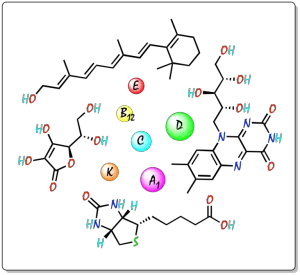Vitamins and vitamers
Vitamins are a group of organic molecules that, in very small amounts (micronutrients), are essential for the normal functioning of the human body.
In addition, they have very diverse chemical and physiological functions and are widely distributed in natural foods.

For many of the vitamins, biological activity is attributed to a series of structurally related compounds known as vitamers. The vitamers belonging to a given vitamin show, in most cases, similar biological properties to each other. However, due to subtle differences in their chemical structures, they exhibit varying degrees of potency. The vitamers of a vitamin can be converted into each other and vice versa.
Video About Vitamins and Minerals
Examples
For example, vitamin A1 has at least six vitamers that qualify as vitamin A, each with slightly different properties. In such a system, vitamin A is referred to as the “generic vitamin descriptor”, which is defined by its biological properties in a vitamin-deficient organism, not by its chemical structure.
In the vitamin A1 system, four of these are found naturally in plant foods and are structures of the carotenoid family (three carotenes and one is a xanthophyll).
What are provitamins?
On the other hand, provitamins are vitamin precursors, i.e. natural substances that are not vitamins themselves, but which the body’s normal metabolism can convert into vitamins.
Most vitamins are essential in the human diet because the body’s tissues cannot synthesize them. However, there are two exceptions which are vitamin D and niacin. Cutaneous synthesis of vitamin D is synthesized in the skin but depends on adequate exposure of the skin to sunlight. On the other hand, niacin synthesis depends on sufficient intake of its amino acid precursor, tryptophan, bound to protein.
Unlike the human organism, plants have the ability to synthesize vitamins, with the exception of vitamin B12, and serve as primary sources of these essential dietary elements.
Classification by solubility.
In human nutrition, 13 vitamins are recognized, and are normally classified into two groups according to their solubility, which is useful to know the mechanisms of assimilation.
Classification by biological function
Vitamins can also be classified according to the biological function they perform. Vitamins have different biochemical functions which are listed below. Even some of them such as vitamin A have different.
As coenzymes of intermediary metabolism
It includes the vitamins of the B group:
- B1 (thiamine): plays a fundamental role in the metabolism of carbohydrates; its deficiency produces, above all, neurological alterations.
- B2 (riboflavin): plays a key role in carbohydrate, lipid and amino acid metabolism. Component of the coenzymes flavin mononucleotide (FMN) and flavin adenine dinucleotide (FAD). It is essential in the electron transport chain, Krebs cycle, in β-oxidation.
- B3 (niacin, vitamin PP, nicotinic acid, niacinamide): involved in a multitude of oxidation-reduction (redox) reactions. From vitamin B3, NAD and NADP are produced.
- B5 (pantothenic acid): structural component of coenzyme A and acyl carrier protein (ACP). Very important in the metabolism of GAs.
- B6 (pyridoxine, pyridoxal and pyridoxamine): mainly involved in the metabolism of amino acids.
- B8 (biotin, vitamin B7, vitamin H): coenzyme of carboxylase enzymes, involved in critical processes of intermediary metabolism.
Vitamins that act on cell proliferation
- B9 (folic acid and folinic acid)
- B12 (cyanocobalamin, hydroxycobalamin)
Vitamins that act as antioxidants
The organism possesses numerous defense mechanisms against free radicals, highly pro-oxidant species. Within the defense mechanisms, vitamins E (tocopherols and tocotrienols), C (ascorbic acid) and to a certain extent vitamin A (retinol, retinoids and carotenoids) play a relevant role.
Vitamin that acts on visual function and gene expression.
Vitamin A (retinol, retinoids and carotenoids) plays an essential role for proper health. It acts in important processes such as vision, cell differentiation, growth, reproduction, immune response, etc.
Vitamins that act on calcium and phosphorus metabolism.
This is vitamin D (ergocalciferol, D2 and cholecalciferol D3), which is actually a prohormone that has no biological activity until it is converted into hormone D.
Vitamin that acts in the blood coagulation process.
Set of compounds called vitamin K (K1 or phytoquinone, K2 or menaquinone, and K3 or menadione).
Conclusion
There are 13 vitamins that are essential components of the human diet. Vitamins are called micronutrients because we need them in very small amounts. They can be classified as fat-soluble (vitamins A, D, E and K) or water-soluble (vitamins B1, B2, B3, B5, B6, B7, B9, B12 and C).
Most of them, except vitamin D and small amounts of B3, must be incorporated in the diet, and inadequate intake leads to deficiencies. The most common deficiencies, in developed countries, are usually those of vitamins B6, B12, C, D and folic acid.
Vitamin B12 (cobalamin) is important for DNA synthesis, nervous system health, amino acid and fatty acid metabolism, and together with vitamin B9 (folate), is essential for the maturation of red blood cells. Vitamin B3 (niacin) is a precursor of the coenzymes nicotinamide adenine dinucleotide and nicotinamide adenine dinucleotide phosphate, key in metabolic pathways. Likewise, vitamin B2 (riboflavin) is a component of flavin nucleotides that are key to respiration.
Inadequate dietary intake of vitamins causes different types of diseases. For example, vitamin B1 (thiamine) deficiency can cause memory loss (e.g. Wernicke/Korsakoff syndrome and in chronic alcoholics); acute and chronic pancreatitis and chronic liver diseases cause impaired fat absorption, which affects the absorption of fat-soluble vitamins; lack of folate can cause anemia and, during pregnancy, developmental disorders in newborns.
In summary, vitamins are an integral part of human health and metabolic pathways, being essential components of enzymes.